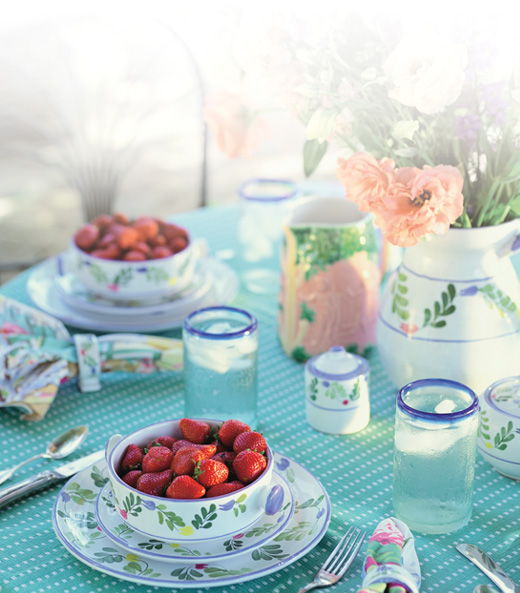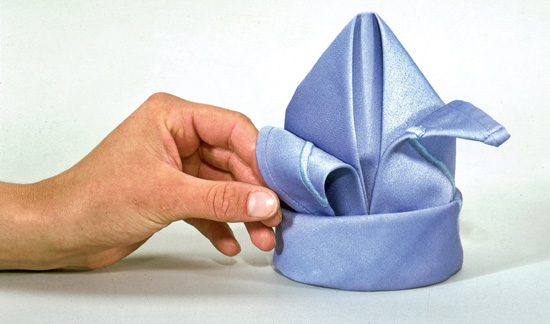
The choice of fabric and color does much to set the tone of a kitchen or dining room. Choose table linen, napkins and dish towels that add personality to the room and provide a warm welcome for both family and guests.
Vary your choice of tablecloths and napkins according to the occasion—be it a formal celebration, a family dinner or child’s party. Buy dish towels in a variety of colors and fabrics, so that you can easily find one or more to fit in with your decor, taste or requirements.
• Buy table linens that match your dinner service.
• Opt for a tablecloth in linen or cotton. Wash at the highest possible temperature safe for the fabric to be sure that any stains come out.
• Check that colored tablecloths are colorfast or they will fade when washed.
• Make sure a new lace tablecloth is washable up to about 140°F (60°C).
• Before adding lace trim to a tablecloth, preshrink cotton lace by washing it. Otherwise, you risk having to remove it and sew it back on again.
• For everyday family use, consider a plastic tablecloth. They are extremely practical—not only for an outdoor table. There are plenty of attractive and contemporary designs and colors.
• For a one-time occasion, consider paper. Paper tablecloths come in many sizes, colors and patterns, but most can be used only once. Thicker ones can be wiped and used again if not stained.
• Use a table runner and place mats to protect a tablecloth. They can also be used to cover stains (though you should always have a fresh tablecloth on hand for emergencies).
• Place mats are made in many different materials, but for households with children, wipeable plastic mats are ideal.
• You can lay a table runner across the table to add color and style as well as to protect the table from scratches, scuff marks and stains.
• Get some small decorative metal or heat-resistant wooden trivets so you can put pots directly on the table safely.
• Choose cloth napkins to add a note of elegance to a dinner party. For everyday use and less formal occasions, pick paper napkins that match the decor.
HARMONIZE LINENS and your DINNER SERVICE for an attractive table.
The dish towel is an essential kitchen item. It is used countless times for drying dishes and handling pots. As well as soaking up water and spills, dish towels also harbor bacteria so must be washed regularly. However, the characteristics of each fabric differ—some are much more absorbent and therefore dry more effectively than others.
• Cotton dish towels are the cheapest option but they tend not to be the best choice. They don’t dry especially well and often start to smell after a while. Even several washings may not eliminate the odor, so consider a cotton dish towel as a last choice.
• Linen or half-linen dish towels are absorbent and they dry items well without shedding lint on sparkling glasses. They tend to be durable, although they need to be washed a few times before using to lose their stiffness so they work their best.
• Microfiber dish towels are a more modern solution, absorbing up to five times as much water as an ordinary dish towel. They also dry rapidly after use. Microfiber is made from a blend of tiny nylon and polyester strands that are woven together. The only disadvantage is that people with very dry skin or eczema might find that microfiber dish towels can be annoyingly clingy and irritating to their skin.
• Always wash dish towels in the hottest possible water to kill germs.
• Avoid using chemical fabric softeners for dish towels as these leave a coating on the towel that keeps it from drying dishes properly. Try using regular white vinegar as a softener instead. It has the additional advantage of eliminating unpleasant odors, even from cotton dish towels.
Folding a napkin into a lily
1 Fold a napkin into a triangle, then turn the right and left corners up to the upper tip to form a square again.
2 Now fold up two-thirds of the lower tip and then back down again to the bottom line. The top must not be longer than the bottom piece or else the folded napkin may tip over.
3 Fold the napkin together by folding back the left and the right sides to the rear, and then tucking one tip into the fold of the other. Round out the shape by hand.

4 Finally, turn down both upper corners to form the leaves of the lily.